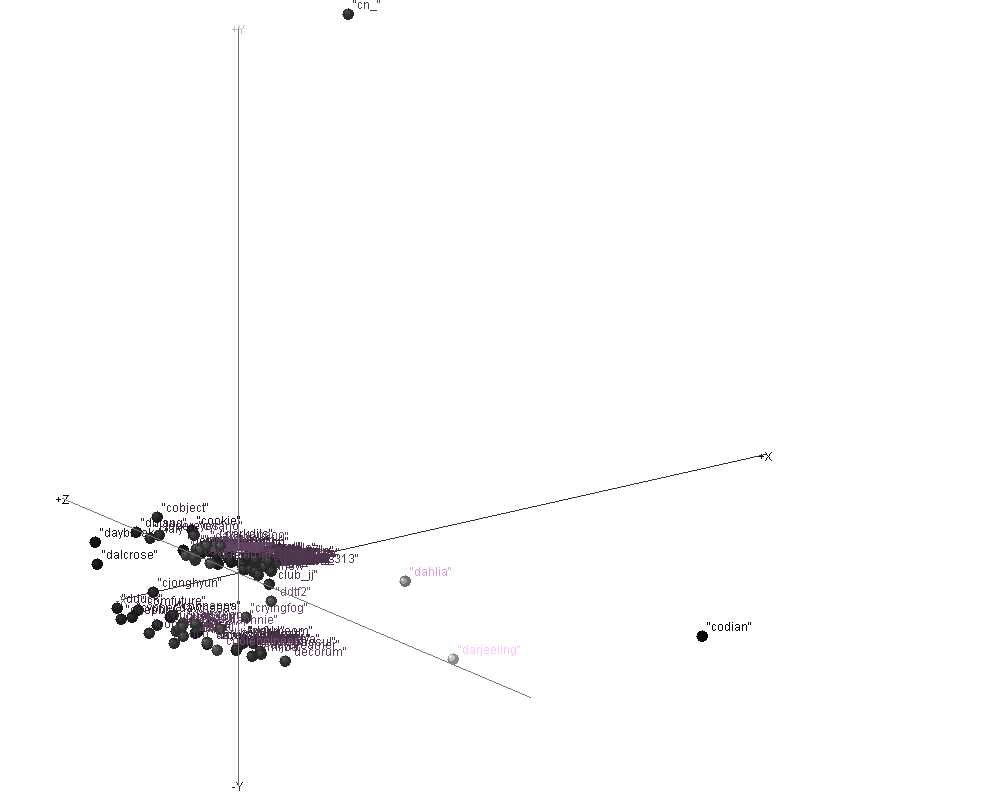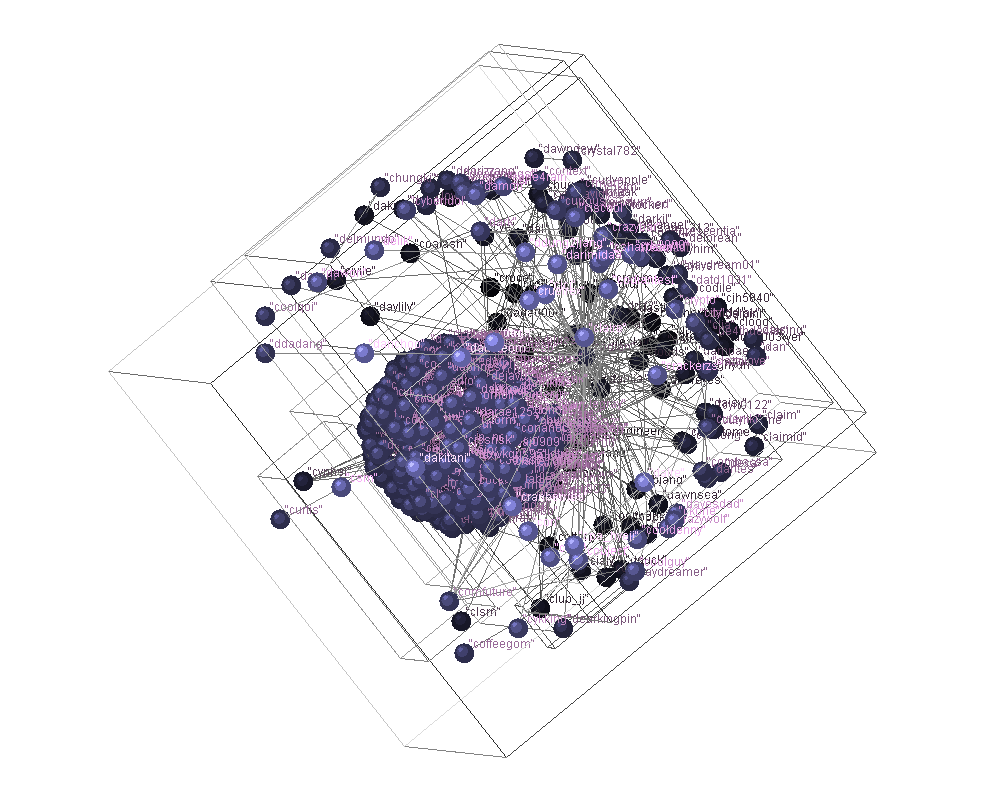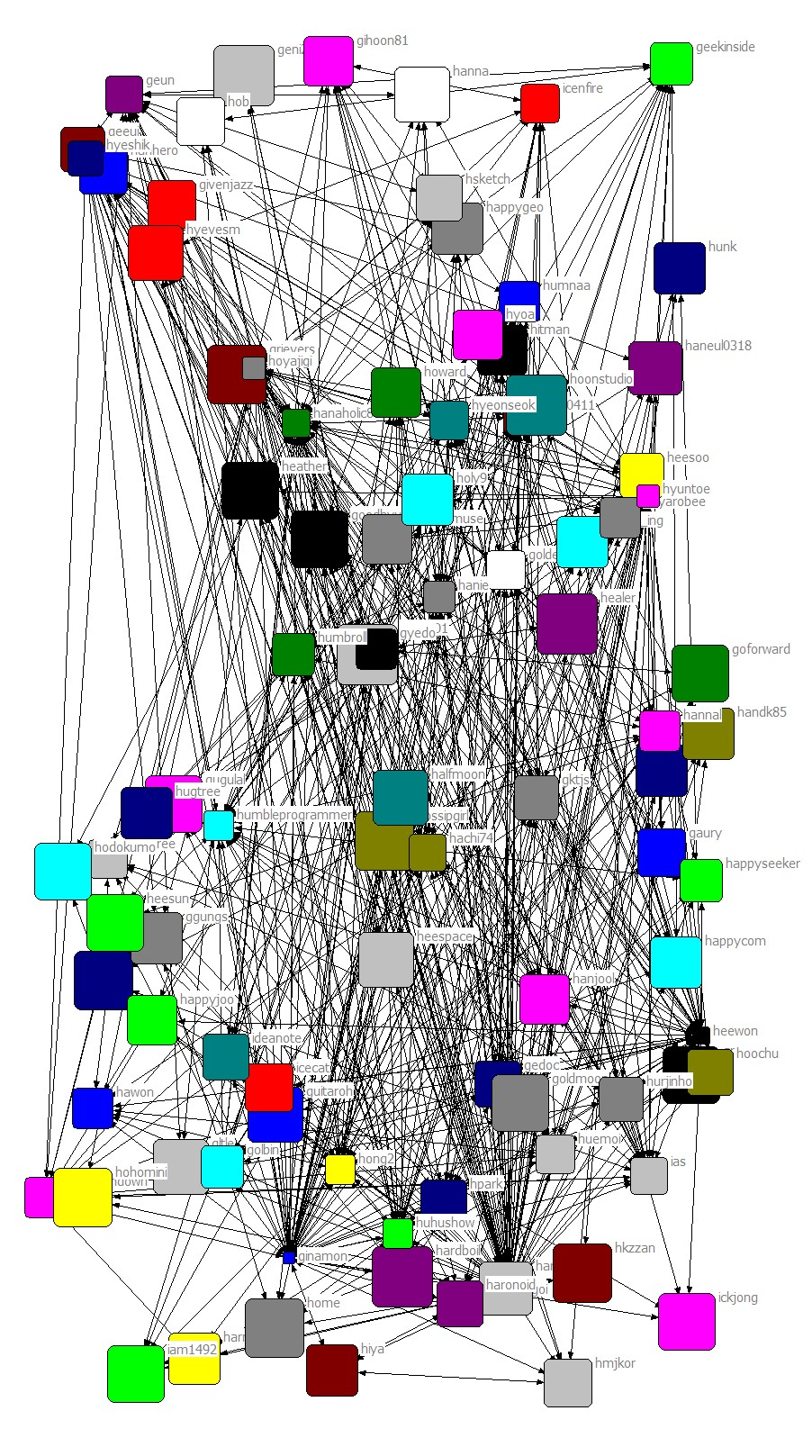About the project ¶
This project aims at exploring structural features of social network service, Me2Day (http://me2day.net/). It focuses on the configuration of relationships among the members and how they interact with each other based on the features provided in Me2Day.
It also examines users' perception of the service and uses of it -- i.e., How they gratify Me2Day uses -- information vs. socio-emotional purpose, what is the nature of members' being recognized, how the users compare the service to other services.
![[http]](/imgs/http.png) Find information about a user
Find information about a user![[http]](/imgs/http.png) Find friends of a user
Find friends of a user![[http]](/imgs/http.png) A script of users' list, the whole
A script of users' list, the whole![[http]](/imgs/http.png) users' attribute data
users' attribute dataResource magazine ¶
http://me2day.net
http://codian.springnote.com/pages/89009
![[http]](/imgs/http.png) http://justhing.dahlia.kr/me2php/ me2 php
http://justhing.dahlia.kr/me2php/ me2 php
http://codian.springnote.com/pages/89009
![[http]](/imgs/http.png) http://justhing.dahlia.kr/me2php/ me2 php
http://justhing.dahlia.kr/me2php/ me2 phpCheck this WP first,  Social_network_analysis_software
Social_network_analysis_software
![[http]](/imgs/http.png) JUNG, Java Universal Network/Graph Framework
JUNG, Java Universal Network/Graph Framework
![[http]](/imgs/http.png) NODEXL
NODEXL
![[http]](/imgs/http.png) Pajek
Pajek
![[http]](/imgs/http.png) Sonivis or
Sonivis or ![[http]](/imgs/http.png) visit here
visit here
![[http]](/imgs/http.png) JUNG, Java Universal Network/Graph Framework
JUNG, Java Universal Network/Graph Framework![[http]](/imgs/http.png) NODEXL
NODEXL![[http]](/imgs/http.png) Pajek
Pajek![[http]](/imgs/http.png) Sonivis or
Sonivis or ![[http]](/imgs/http.png) visit here
visit here![[http]](/imgs/http.png) R project: Modules required. R is a complete statistics program.
R project: Modules required. R is a complete statistics program. ![[http]](/imgs/http.png) Statnet: An integrated set of tools for the representation, visualization, analysis and simulation of network data. This package For an introduction type: help(package='statnet')
Statnet: An integrated set of tools for the representation, visualization, analysis and simulation of network data. This package For an introduction type: help(package='statnet')![[http]](/imgs/http.png) tnet : tnet is a package written in R to serve two purposes:
tnet : tnet is a package written in R to serve two purposes:- Calculate social network measures on weighted datasets
Not everyone is the same. Some people are close to us, whereas others are just acquaintances. Few network measures, and fewer network analysis programmes, can deal with datasets where the ties are differentiated by weights. By removing the weights of relations, we are removing a lot of the richness within the dataset. This means that we are limiting the weight analysis to sensitivity analyses, which are difficult to interpret. A close friendship is not the same as an acquaintance.
- Detect underlying principles that guide tie formation in datasets with time-stamped ties
Network analysis is often based on static networks. In these networks there are issues of dependence as everything depends on everything. Therefore it is difficult to say why certain ties are created and others are not. In networks where the exact sequence of ties is know, the endogeneity issue can be dealt with. This type of data is generally from online communities, email networks, and telephone networks (if your dataset is not like this, but collected in waves, try Siena).
![[http]](/imgs/http.png) sna: A range of tools for social network analysis, including node and graph-level indices, structural distance and covariance methods, structural equivalence detection, p* modeling, random graph generation, and 2D/3D network visualization.
sna: A range of tools for social network analysis, including node and graph-level indices, structural distance and covariance methods, structural equivalence detection, p* modeling, random graph generation, and 2D/3D network visualization.Structural feature of the me2day.net social network
via frequency of friends
via frequency of comments (reply)
via frequency of commentators
What do they get?via frequency of comments (reply)
via frequency of commentators
check overlap between friends and commentator.
Temp work bed ¶
 MDS visualization [PNG image (23.01 KB)] |  Cluster visualization of friend's network [PNG image (140.31 KB)] |
 Visualization of Core [PNG image (16.05 KB)] |  Centrality figure [PNG image (886.46 KB)] |
DENSITY / AVERAGE MATRIX VALUE
--------------------------------------------------------------------------------
Input dataset: F:\Works\KISDI\testing\29-39
Output dataset: F:\Works\KISDI\testing\29-39-density
Density No. of Ties
-------------- --------------
29-39 0.0023 2300.0000
----------------------------------------
Running time: 00:00:01
Output generated: 31 3 09 17:37:39
Copyright (c) 1999-2008 Analytic Technologies










